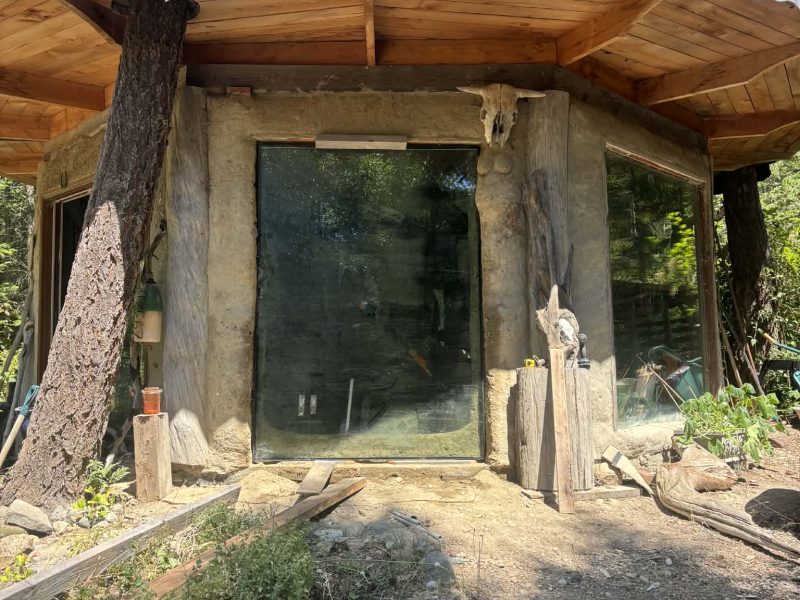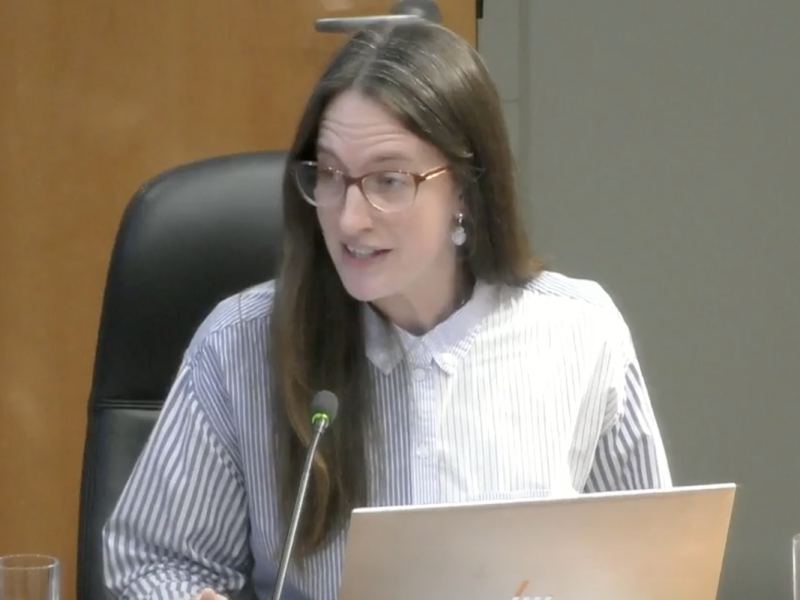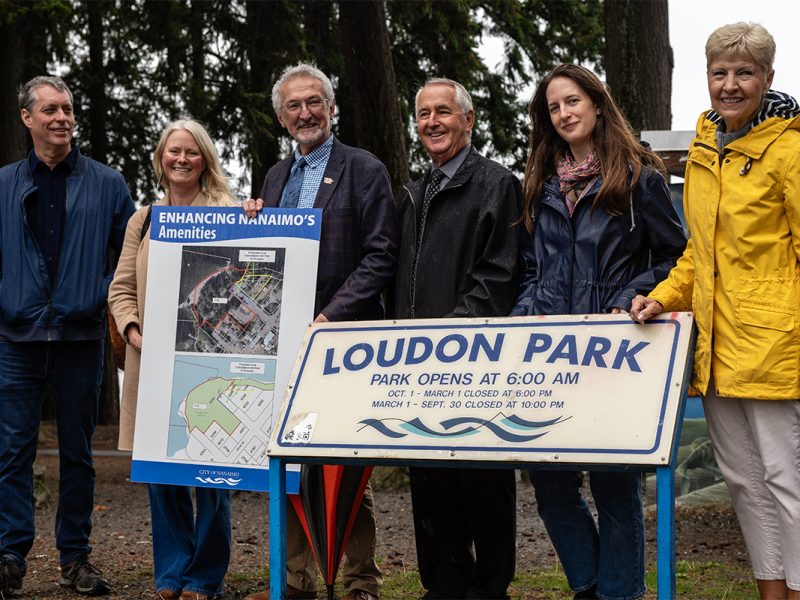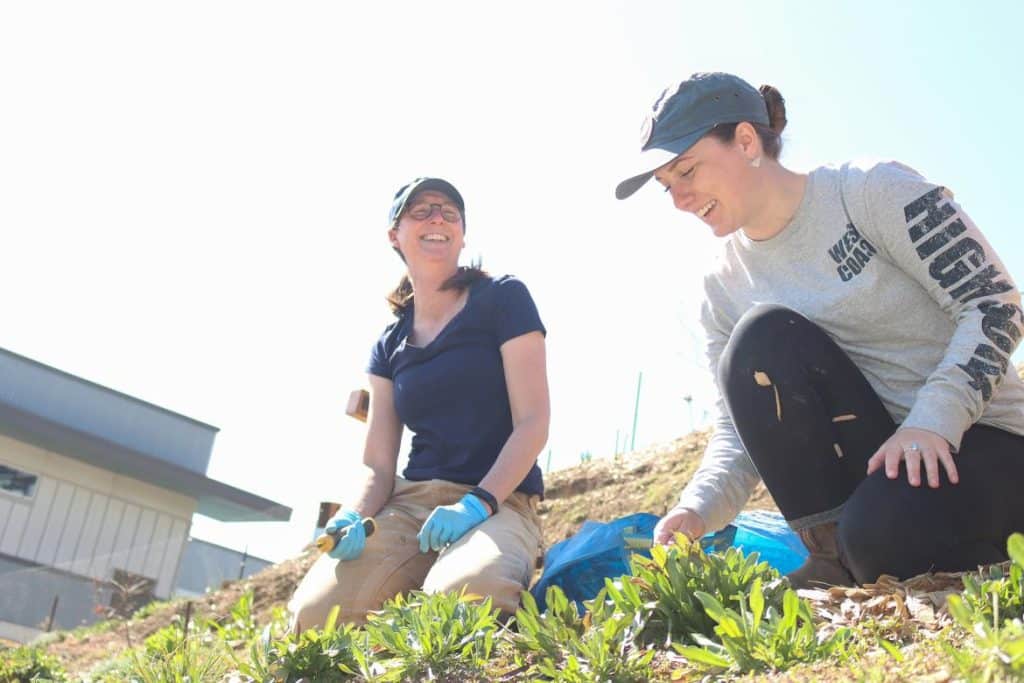
The p’hwulhp ecosystem restoration project at Vancouver Island University (VIU) covers the side of a hill just below the university’s sturgeon hatchery facilities. A narrow path cuts back and forth along the hill face, weaving between batches of speenhw (camas), t’uliqw’ulhp (yarrow) and q’uxmin (bare stem biscuitroot).
As Caroline Josefsson, Ph.D. and co-chair of VIU’s biology department, leads a tour through the 500-square-metre restoration plot, she’s quick to bend down and pull a small bit of greenery from the soil.
“This is,” Josefsson turns to show the tiny two-leaf purple plant she holds to the group following her around. “I can’t remember the name tonight, it seems. But it’s such a common weed we have to pull, I can recognize it from a mile away now.”
Josefsson calls to another member of the restoration group, who is crouched low amongst a gathering of fenced-off plants. “Hunter, what is this one again?”
VIU student Hunter Jarratt has made a name for himself as The Invasive Species Guy on social media platforms, detailing ways to identify the more than 170 invasive species found throughout the province. With the deft footing of someone who knows the area well, Jarratt is quick to hop from one level of the plot down to one closer to Josefsson.
“That’s the Queen Anne[‘s Lace]. I’m pulling a bunch of it from the saplings.” Jarratt opens his hand to show the group a squished clump of dark purple and brown leaves. “They’re quick to overshadow the native species here, so we try and stay on top of it.”
He returns to the collection of fenced plants, p’hwulhp (briefly known as Garry oak) seedlings and saplings at various stages of growth, guarded from VIU’s notorious rabbit population with wire fencing.
P’hwulhp trees are the only native oak species to grow west of Manitoba. The dry, Mediterranean-style p’hwulhp ecosystem is scattered within the larger coastal Douglas fir zone, with a Canadian range limited to the southeast coast of Vancouver Island and the southern Gulf Islands. P’hwulhp ecosystems cover less than 0.3 per cent of the province.
Scientists believe the range of p’hwulhp ecosystems likely became smaller and patchier as the climate got wetter and cooled. Now, as the climate becomes hotter and drier and Douglas fir struggle, the deep roots and waxy leaves of p’hwulhp may help the wider ecosystem adapt.
While the term Garry oak comes from deputy governor Nicholas Garry of the Hudson’s Bay Company from 1822 to 1835, p’hwulhp is a Hul’qumi’num name distinct to the deciduous tree that provides the base for a unique ecosystem.
P’hwulhp meadows host over 70 species native to the area that have become staple medicines and food sources. With an ecosystem footprint that registers as one of the most diverse throughout B.C., p’hwulhp meadows are a haven for species like Cooper’s hawks and Northern alligator lizards.
VIU’s p’hwulhp restoration project, and other native plant restoration projects on campus, aims to protect this rare ecosystem and grow knowledge about its benefits in the wider community.
Time is of the essence. In regions of Nanaimo, Parksville and Nanoose just 33 per cent of the p’hwulhp habitats from 1800 exist today, according to the Garry oak Ecosystem Recovery Team, largely as a result of development.
The prairie-style landscape of most p’hwulhp habitats throughout Vancouver Island was a magnet for resource extraction-related development from the 1800’s to early 1900’s, leaving many species threatened due to loss of habitat.
As European settlers cleared First Nations land to make way for agriculture and housing, they also introduced invasive plants like Scotch broom and Queen Anne’s lace, choking out native plants. As a result of these pressures, p’hwulhp ecosystems are now among the most endangered in the province
Could p’hwulhp ecosystems help with climate resiliency?
Started in 2021, VIU’s p’hwulhp ecosystem restoration project has already seen the effects of bringing native plants back to the area.
“We have our resident garter snake, Thicc Boi, who we often see around,” Josefsson excitedly lists off the fauna that have been spotted returning to the newly developing ecosystem. “And blue dashers (Pachydiplax longipennis) have been spotted. I’ve been told we’ve had butterflies, but I haven’t seen them here enough for my satisfaction.”
Though p’hwulhp ecosystems are largely drought resistant, Josefsson notes the dry spring has challenged the university’s particular plot.
“We have seedlings here,” she motions to a noticeably bare part of the lot, small circles of rocks helping support soil troughs with the tiniest of seedlings poking through. “But they didn’t establish properly and I’m out here often watering to help them along.”
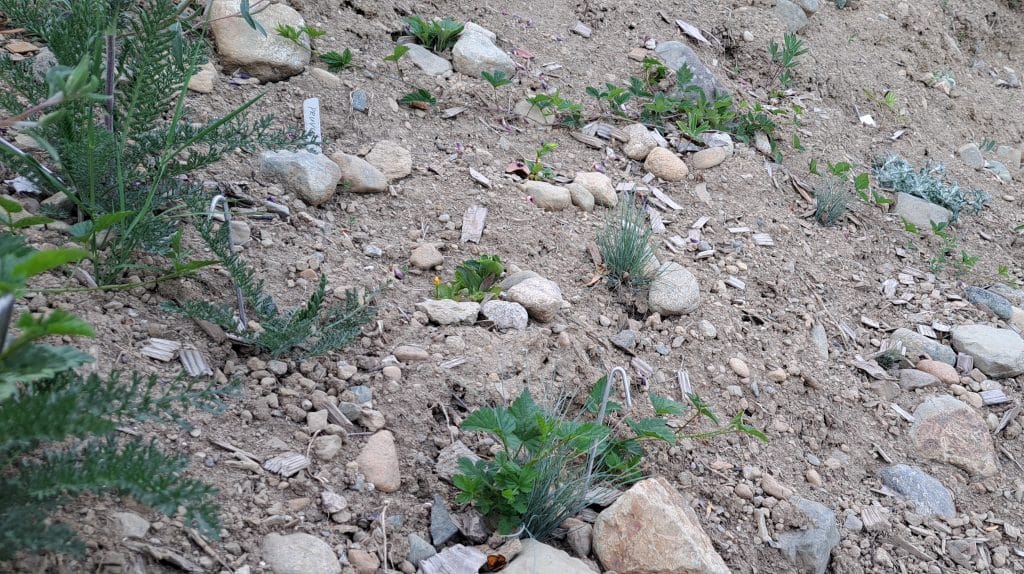
Current 2023 drought predictions could see this year as one of the worst on record. May’s record-setting temperatures sapped much of the snowpack reserve.
In a 2018 co-authored paper, Josefsson noted that a particular trait within p’hwulhp species could help aid the trees in surviving further effects of the climate crisis. Because of p’hwulhp’s ability to easily pass on genetic differences to next generations, Josefsson predicts that if a singular p’hwulhp develops a trait that aids in climate resilience it could soon be found in future generations.
When The Discourse asked if this resilience extends to other species in p’hwulhp ecosystems, Josefsson is less hopeful.
“Going back to our seedling patch there, this spring already has pushed them far past their limits,” Josefsson explains, laying out her morning tasks of coming out to hose down the seedling patch in an attempt to counter this year’s early drought conditions. “When we have the area more established, I can see the general ecosystem helping new seedlings along.”
But Josefsson worries future p’hwulhp ecosystem restoration projects will need a large amount of aid to survive and establish. A look at how far along the current p’hwulhp seedlings are gives an idea of the timeline involved.
“This one here is about three years old, I want to say,” Jarratt points to a leafy sapling that stands a mere foot high. What the p’hwulhp sapling currently lacks in height it boasts in deep green leaves that branch out and offer cooling shade for the soil just underneath.
“That’s actually pretty average growth, it’s doing well.”
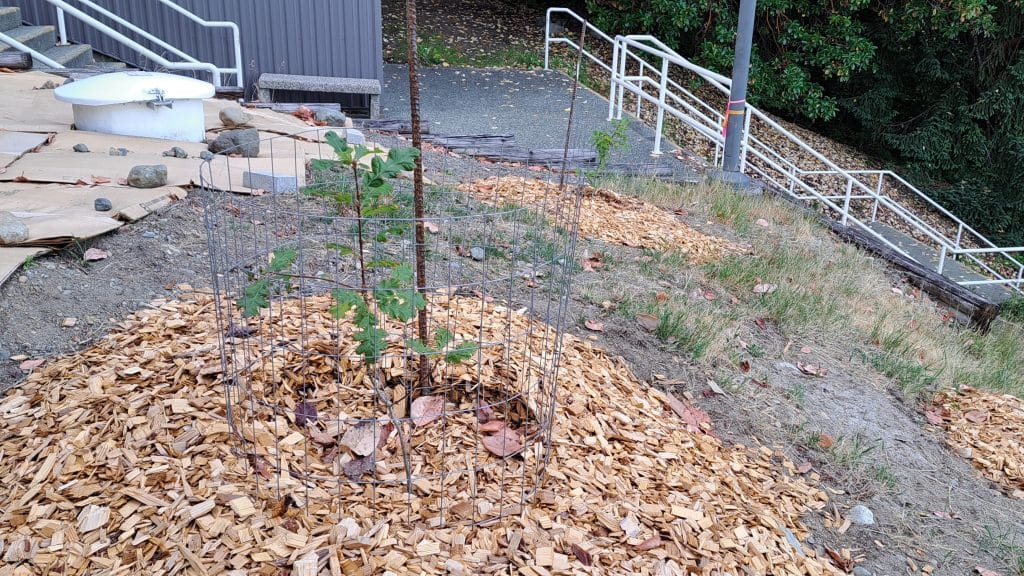
Throughout the tour, both Josefsson and Jarratt touch on the various threats pushing p’hwulhp ecosystems to such a restricted footprint.
“Development, of course,” Jarratt tells The Discourse. “Gary oak meadows (p’hwulhp ecosystems) usually inhabit good development areas.”
P’hwulhp ecosystems can be divided into two categories, deep soil sites and scrub oak shallow soil sites. Only 1.5 per cent of pre-contact deep soil sites remain, having been used for agriculture throughout the Island and urban development largely around Victoria. While 44 per cent of scrub oak shallow soil sites remain due to the rocky ground being a barrier to development, these areas are often overwhelmed with invasive species like Scotch broom.
A tour guest mentions the Harewood Plains Environmentally Sensitive Areas Project located at McKeown Way and Extension Road, a restoration project taken on by the Garry oak Ecosystems Recovery Team in partnership with Environment Canada, Ministry of Environment, City of Nanaimo and Friends of Harewood Plains.
While currently protected, the guest notes that a developer recently approached the City of Nanaimo about potential rezoning to create a subdivision within Harewood Plains surrounding Lotus Pinnatus Park, leading members of the community to contact city council asking to protect Harewood Plains.

Josefsson notes the need for housing and the need to protect current and future p’hwulhp ecosystems is a balancing act she struggles with.
“We need housing, I completely get that. So many of my students, ones recently graduated and ones just starting out in the program, they’re all struggling with housing in one way or another,” Josefsson says, noting that the housing crisis leads to another unique threat towards p’hwulhp ecosystems and restoration efforts.
“Many of my best students, ones who are passionate about these species, they tell me they can’t afford to live here for much longer. We’re losing so many people with the skills to keep Gary oak meadows from losing more ground.”
As the spring semester comes to a close, Josefsson is getting ready to say goodbye to some of the graduating students who’ve worked tirelessly to establish the small plot. Jarratt and restoration partner Megan Kollman, part of VIU’s Natural Resource Protection program, both graduate this year, and Josefsson is excited to see them head out to take on future land management projects.
“This,” she motions to the plot as the evening sun dips behind the sturgeon hatchery building and sends it all into a shady relief. “This will still be here. New students will learn so much from this project and how we can build from here.”

